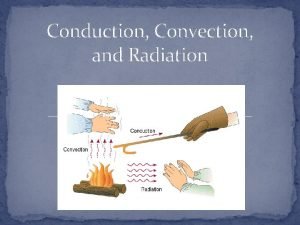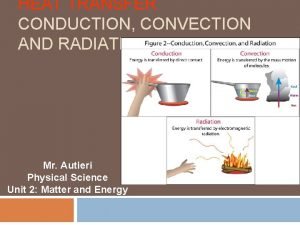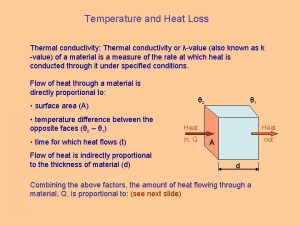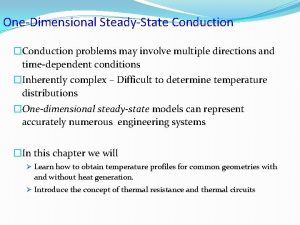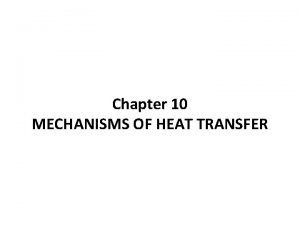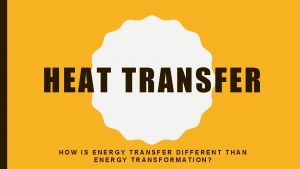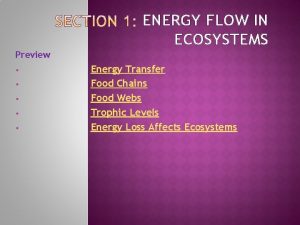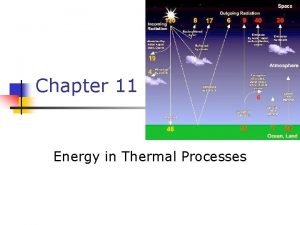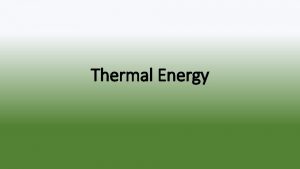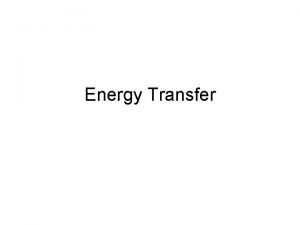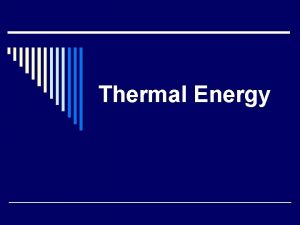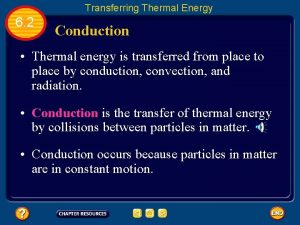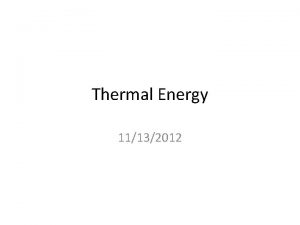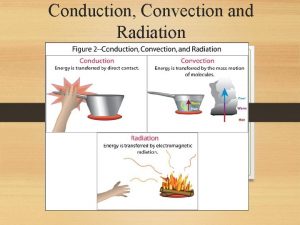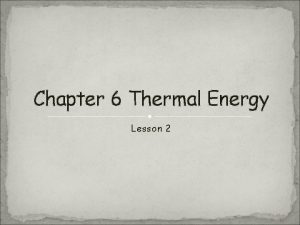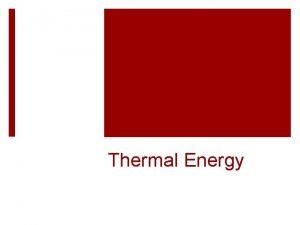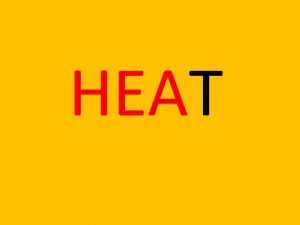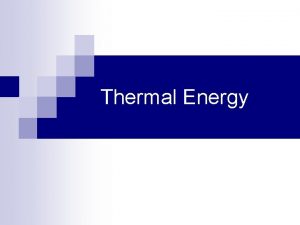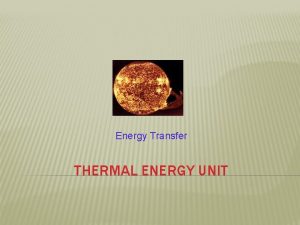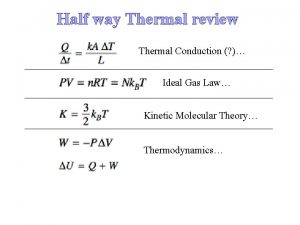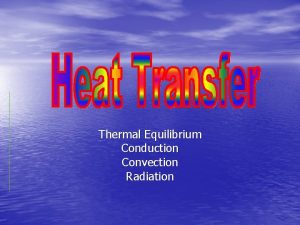Conduction Thermal energy is transferred from place to



















- Slides: 19

Conduction • Thermal energy is transferred from place to place by conduction, convection, and radiation. • Conduction is the transfer of thermal energy by collisions between particles in matter. • Matter must be touching!

Thermal Conductors • The rate at which thermal energy is transferred depends on the material. • Thermal energy transfers faster by conduction through solids and liquids than through gases. Why? • The best conductors of thermal energy are metals. • In a piece of metal, there are electrons that are not bound to individual atoms, but can move easily through the metal.

Convection • Liquids and gases can flow and are classified as fluids. • Only in fluids can thermal energy can be transferred by convection. • When a fluid expands, its volume increases, but its mass doesn’t change. • As a result, its density decreases. d=mv

Convection Currents • Convection currents transfer thermal energy from warmer to cooler parts of a fluid. • In a convection current, both conduction and convection transfer thermal energy.

Radiation • Radiation is the transfer of energy by electromagnetic waves. • Radiation does not require matter in order to travel. The Sun’s energy reaches Earth by radiation. • Energy that is transferred by radiation often is called radiant energy.

Click image to play movie

Radiant Energy and Matter • The amount of energy absorbed, reflected, and transmitted depends on the type of material. • Materials that are light-colored reflect more radiant energy, while dark-colored materials absorb more radiant energy. • When radiant energy is absorbed by a material, thermal energy of the material increases.

Insulators • A material through which thermal energy is transferred slowly is an insulator. • Examples of insulators are wood, some plastics, fiberglass, and air. • Material, such as metals, that are good thermal conductors are poor insulators. • Gases, such as air, are usually much better insulators than solids or liquids. • Some types of insulators contain many pockets of trapped air.

Heating Systems • Most homes and public buildings contain some type of heating system.

Heating Systems • In the simplest and oldest heating system, wood or coal is burned in a stove. • The thermal energy that is extracted from burning fuel is transferred from the stove to the surrounding air by conduction, convection, and radiation. • One disadvantage of this system is that heat transfer from the room in which the stove is located to other rooms in the building can be slow.

Forced-Air Systems • The most common type of heating system in use today is the forced-air system. A forced-air distribution system uses a blower to distribute warmed air and to return cold air to the furnace so it can be rewarmed and distributed again.

Radiator Systems • A radiator is a closed metal container that contains hot water or steam. • The thermal energy contained in the hot water or steam is transferred to the air surrounding the radiator by conduction. • This warm air then moves through the room by convection.

Radiator Systems • In radiator heating systems, fuel burned in a central furnace heats a tank of water. • A system of pipes carries the hot water to radiators in the rooms of the building. • After the water cools, it flows through the pipes back to the water tank, and is reheated.

Electric Heating Systems • An electric heating system has no central furnace. • Instead, electrically heated coils placed in floors and in walls heat the surrounding air by conduction. • Thermal energy is then distributed through the room by convection.

Solar Heating • The radiant energy from the Sun can be used to help heat homes and buildings. • There are two types of systems that use the Sun’s energy for heating passive solar heating systems and active solar heating systems.

Passive Solar Heating • In passive solar heating systems, materials inside a building absorb radiant energy from the Sun during the day and heat up. • At night when the building begins to cool, thermal energy absorbed by these materials helps keep the room warm.

Active Solar Heating • Active solar heating systems use solar collectors that absorb radiant energy from the Sun. • The collectors usually are installed on the roof or south side of a building. • Radiant energy from the Sun heats air or water in the solar collectors.

Active Solar Heating • The black metal plate absorbs radiant energy from the Sun. • The absorbed energy heats water in pipes just above the plate.

Active Solar Heating • A pump circulates the hot water to radiators in rooms of the house. • The cooled water then is pumped back to the collector to be reheated.
 During conduction, thermal energy is transferred
During conduction, thermal energy is transferred Radiation examples
Radiation examples Section 3 using thermal energy answers
Section 3 using thermal energy answers What does conduction
What does conduction Identify heat transfer shown in each picture
Identify heat transfer shown in each picture Heat loss symbol
Heat loss symbol Steady state heat conduction
Steady state heat conduction Thermal conduction resistance
Thermal conduction resistance Thermal conduction resistance
Thermal conduction resistance Rconv
Rconv Disturbance that transfers energy
Disturbance that transfers energy A disturbance that transfers energy from place to place
A disturbance that transfers energy from place to place How are thermal energy and temperature different
How are thermal energy and temperature different Thermal energy and mass
Thermal energy and mass How is heat energy transferred
How is heat energy transferred Food diagram
Food diagram Formula for energy transfer
Formula for energy transfer Trophic level transfer efficiency calculator
Trophic level transfer efficiency calculator Thermal transfer vs direct thermal printing
Thermal transfer vs direct thermal printing Energy energy transfer and general energy analysis
Energy energy transfer and general energy analysis

